2023 HYUNDAI IONIQ 6 steering
[x] Cancel search: steeringPage 508 of 582
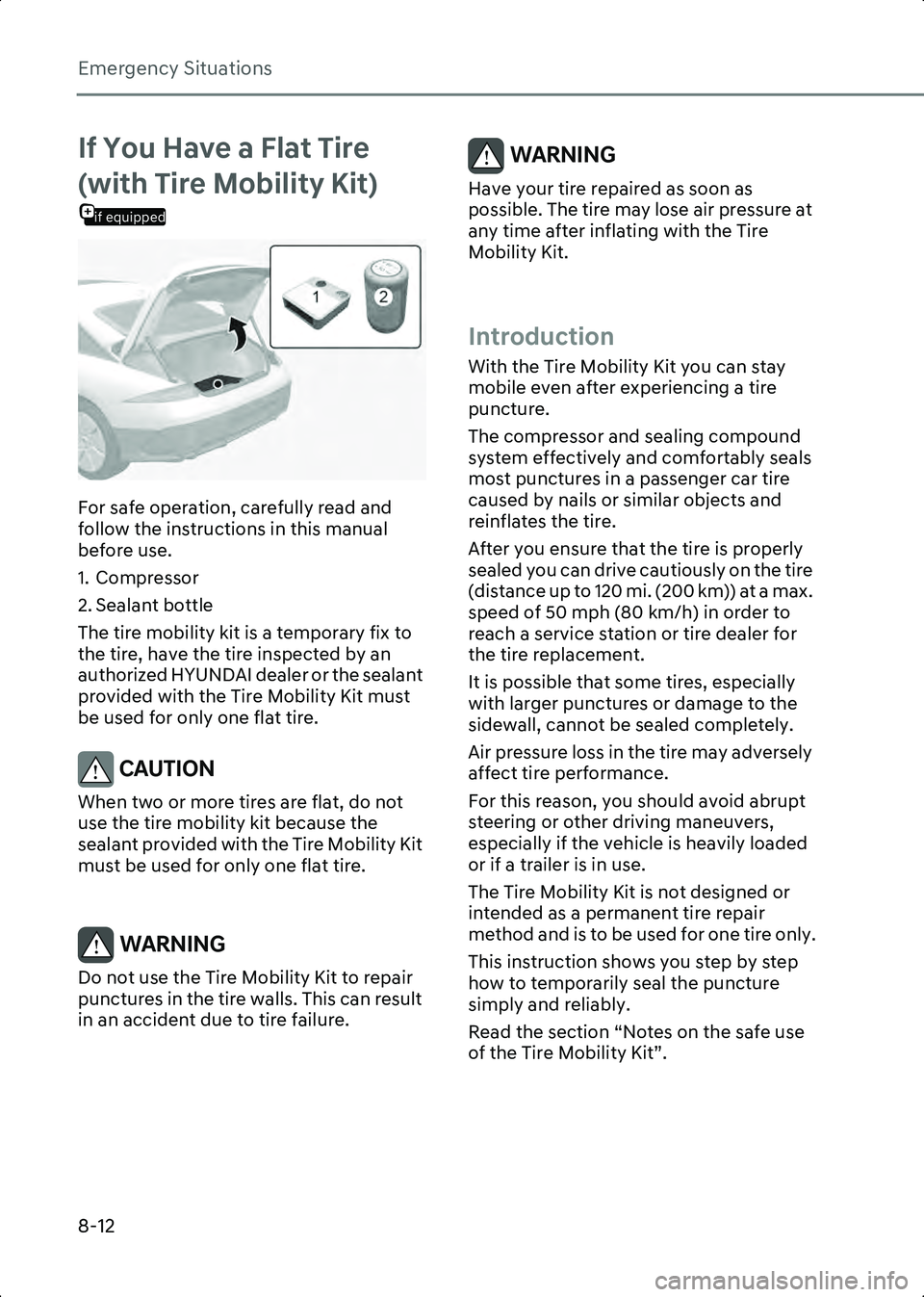
Emergency Situations
8-12
If You Have a Flat Tire
if equipped
(with Tire Mobility Kit)
B8002501
For safe operation, carefully read and
follow the instructions in this manual
before use.
1. Compressor
2. Sealant bottle
The tire mobility kit is a temporary fix to
the tire, have the tire inspected by an
authorized HYUNDAI dealer or the sealant
provided with the Tire Mobility Kit must
be used for only one flat tire.
CAUTION When two or more tires are flat, do not
use the tire mobility kit because the
sealant provided with the Tire Mobility Kit
must be used for only one flat tire.
WARNING Do not use the Tire Mobility Kit to repair
punctures in the tire walls. This can result
in an accident due to tire failure.
WARNING Have your tire repaired as soon as
possible. The tire may lose air pressure at
any time after inflating with the Tire
Mobility Kit.
Introduction
With the Tire Mobility Kit you can stay
mobile even after experiencing a tire
puncture.
The compressor and sealing compound
system effectively and comfortably seals
most punctures in a passenger car tire
caused by nails or similar objects and
reinflates the tire.
After you ensure that the tire is properly
sealed you can drive cautiously on the tire
(distance up to 120 mi. (200 km)) at a max.
speed of 50 mph (80 km/h) in order to
reach a service station or tire dealer for
the tire replacement.
It is possible that some tires, especially
with larger punctures or damage to the
sidewall, cannot be sealed completely.
Air pressure loss in the tire may adversely
affect tire performance.
For this reason, you should avoid abrupt
steering or other driving maneuvers,
especially if the vehicle is heavily loaded
or if a trailer is in use.
The Tire Mobility Kit is not designed or
intended as a permanent tire repair
method and is to be used for one tire only.
This instruction shows you step by step
how to temporarily seal the puncture
simply and reliably.
Read the section “Notes on the safe use
of the Tire Mobility Kit”.
Hyundai_CE_en_US.book Page 12
Page 511 of 582
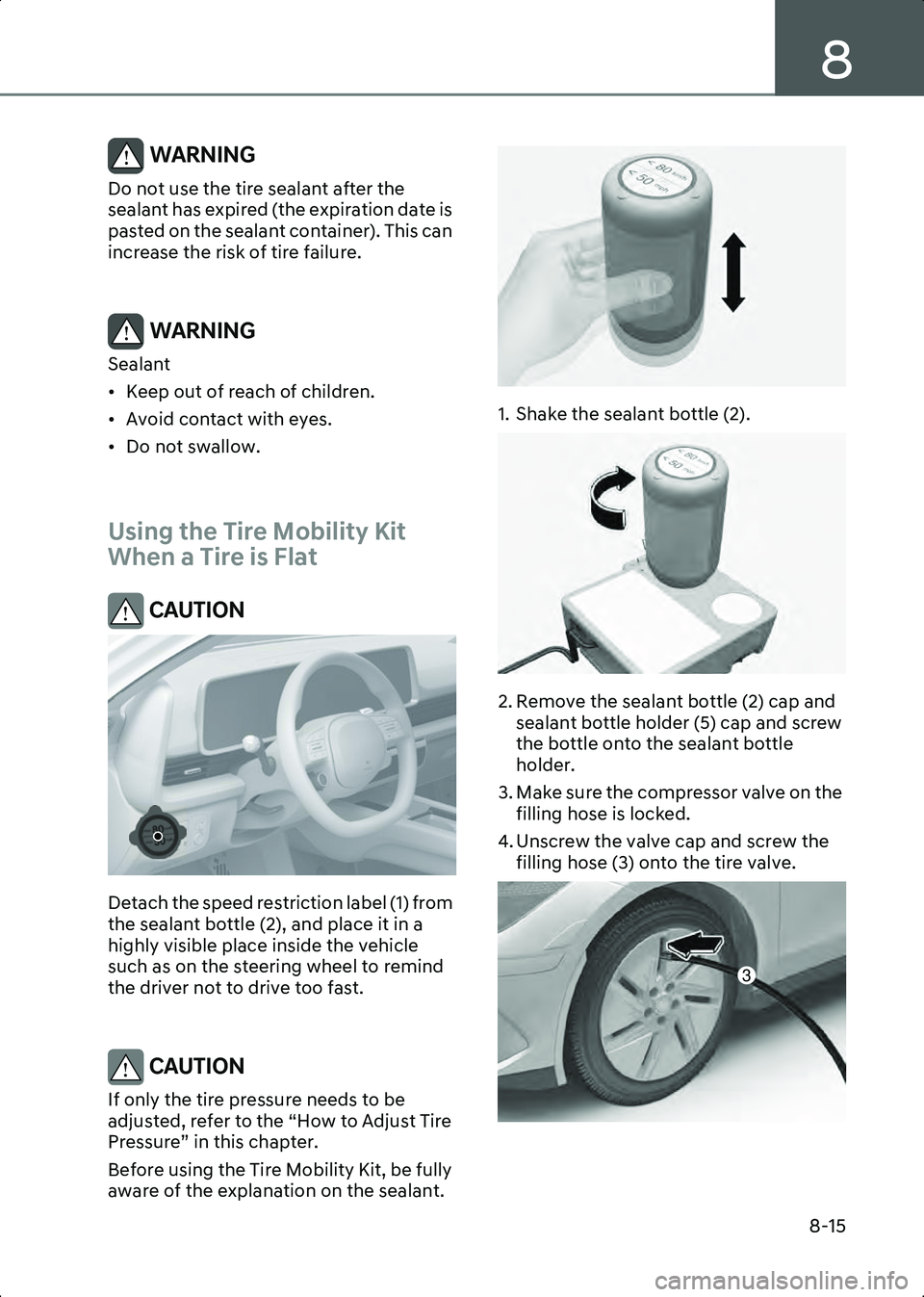
8
8-15
WARNING Do not use the tire sealant after the
sealant has expired (the expiration date is
pasted on the sealant container). This can
increase the risk of tire failure.
WARNING Sealant
• Keep out of reach of children.
• Avoid contact with eyes.
• Do not swallow.
Using the Tire Mobility Kit
When a Tire is Flat
CAUTION
B8002503
Detach the speed restriction label (1) from
the sealant bottle (2), and place it in a
highly visible place inside the vehicle
such as on the steering wheel to remind
the driver not to drive too fast.
CAUTION If only the tire pressure needs to be
adjusted, refer to the “How to Adjust Tire
Pressure” in this chapter.
Before using the Tire Mobility Kit, be fully
aware of the explanation on the sealant.
B8002504
1. Shake the sealant bottle (2).
B8002505
2. Remove the sealant bottle (2) cap and sealant bottle holder (5) cap and screw
the bottle onto the sealant bottle
holder.
3. Make sure the compressor valve on the filling hose is locked.
4. Unscrew the valve cap and screw the filling hose (3) onto the tire valve.
B8002506
3
Hyundai_CE_en_US.book Page 15
Page 517 of 582
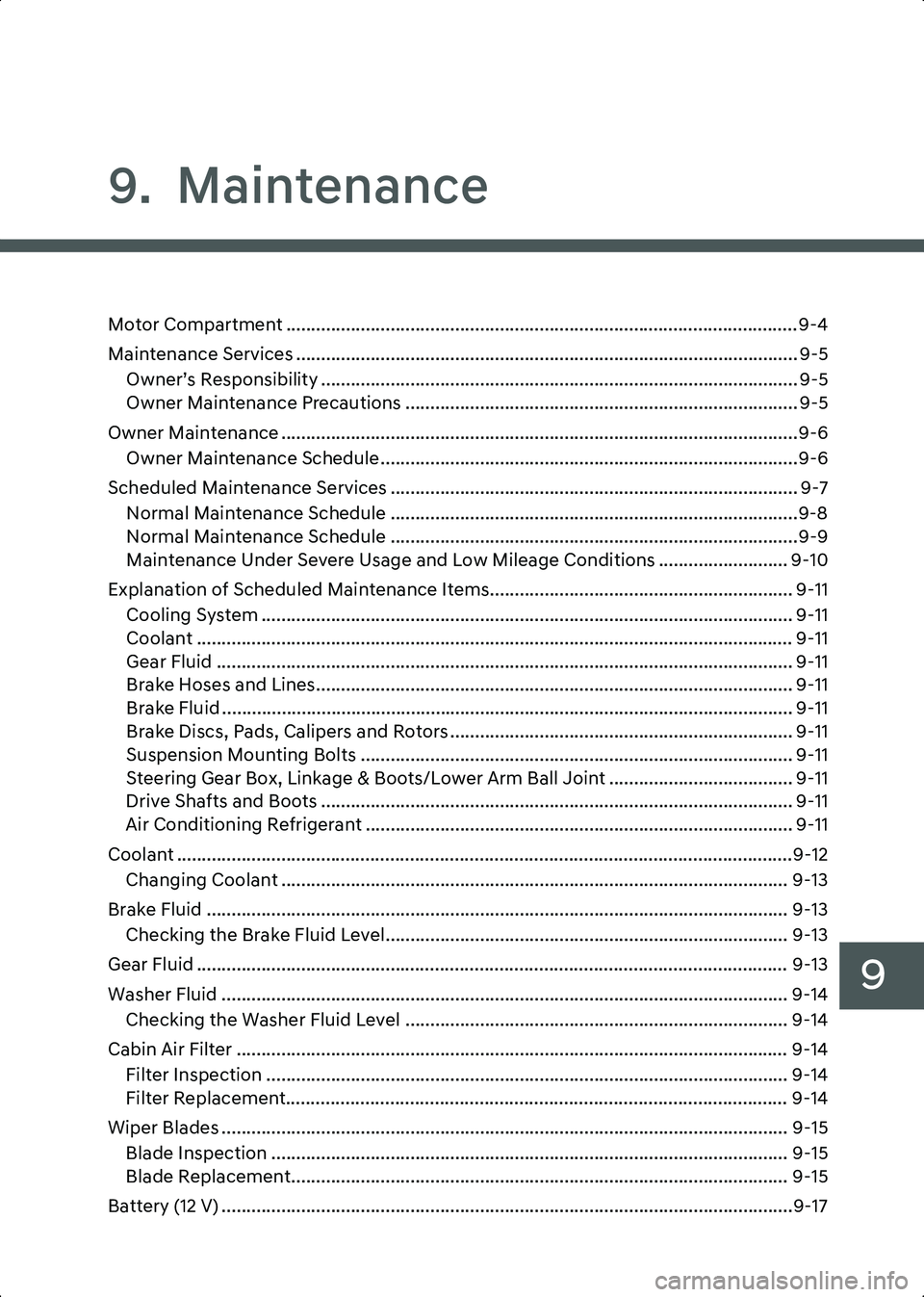
9
9. Maintenance
Motor Compartment ....................................................................................................... 9-4
Maintenance Services ..................................................................................................... 9-5Owner’s Responsibility ................................................................................................ 9-5
Owner Maintenance Precautions ............................................................................... 9-5
Owner Maintenance ........................................................................................................9-6 Owner Maintenance Schedule....................................................................................9-6
Scheduled Maintenance Services .................................................................................. 9-7 Normal Maintenance Schedule ..................................................................................9-8
Normal Maintenance Schedule ..................................................................................9-9
Maintenance Under Severe Usage and Low Mileage Conditions .......................... 9-10
Explanation of Scheduled Maintenance Items............................................................. 9-11 Cooling System ........................................................................................................... 9-11
Coolant ........................................................................................................................ 9-11
Gear Fluid .................................................................................................................... 9-11
Brake Hoses and Lines................................................................................................ 9-11
Brake Fluid ................................................................................................................... 9-11
Brake Discs, Pads, Calipers and Rotors ..................................................................... 9-11
Suspension Mounting Bolts ....................................................................................... 9-11
Steering Gear Box, Linkage & Boots/Lower Arm Ball Joint ..................................... 9-11
Drive Shafts and Boots ............................................................................................... 9-11
Air Conditioning Refrigerant ...................................................................................... 9-11
Coolant ............................................................................................................................9-12 Changing Coolant ...................................................................................................... 9-13
Brake Fluid ..................................................................................................................... 9-13 Checking the Brake Fluid Level................................................................................. 9-13
Gear Fluid ....................................................................................................................... 9-13
Washer Fluid .................................................................................................................. 9-14 Checking the Washer Fluid Level ............................................................................. 9-14
Cabin Air Filter ............................................................................................................... 9-14 Filter Inspection ......................................................................................................... 9-14
Filter Replacement..................................................................................................... 9-14
Wiper Blades .................................................................................................................. 9-15 Blade Inspection ........................................................................................................ 9-15
Blade Replacement.................................................................................................... 9-15
Battery (12 V) ...................................................................................................................9-17
Hyundai_CE_en_US.book Page 1
Page 522 of 582
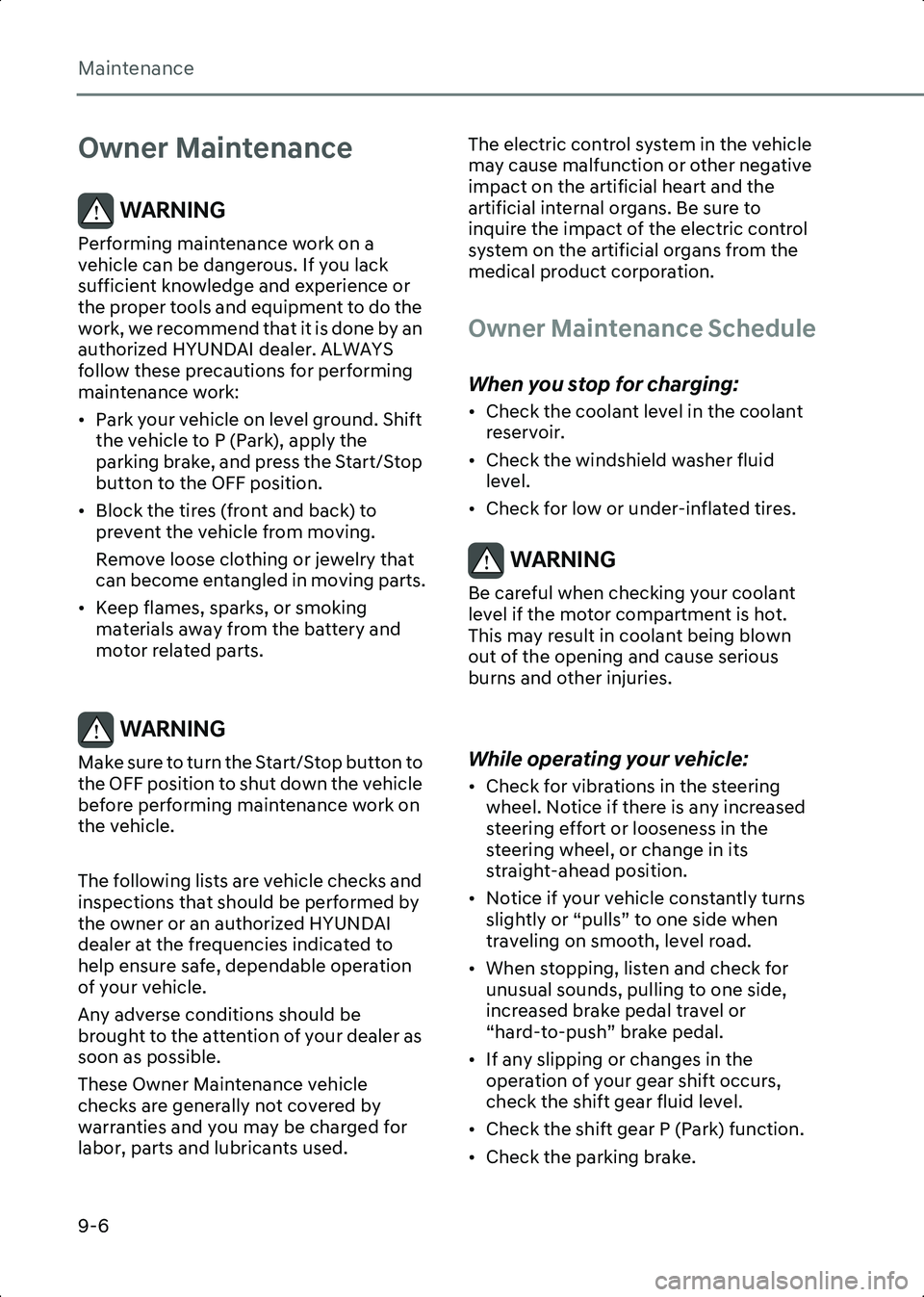
Maintenance
9-6
Owner Maintenance
WARNING Performing maintenance work on a
vehicle can be dangerous. If you lack
sufficient knowledge and experience or
the proper tools and equipment to do the
work, we recommend that it is done by an
authorized HYUNDAI dealer. ALWAYS
follow these precautions for performing
maintenance work:
• Park your vehicle on level ground. Shift the vehicle to P (Park), apply the
parking brake, and press the Start/Stop
button to the OFF position.
• Block the tires (front and back) to prevent the vehicle from moving.
Remove loose clothing or jewelry that
can become entangled in moving parts.
• Keep flames, sparks, or smoking materials away from the battery and
motor related parts.
WARNING Make sure to turn the Start/Stop button to
the OFF position to shut down the vehicle
before performing maintenance work on
the vehicle.
The following lists are vehicle checks and
inspections that should be performed by
the owner or an authorized HYUNDAI
dealer at the frequencies indicated to
help ensure safe, dependable operation
of your vehicle.
Any adverse conditions should be
brought to the attention of your dealer as
soon as possible.
These Owner Maintenance vehicle
checks are generally not covered by
warranties and you may be charged for
labor, parts and lubricants used. The electric control system in the vehicle
may cause malfunction or other negative
impact on the artificial heart and the
artificial internal organs. Be sure to
inquire the impact of the electric control
system on the artificial organs from the
medical product corporation.
Owner Maintenance Schedule
When you stop for charging:
• Check the coolant level in the coolant
reservoir.
• Check the windshield washer fluid level.
• Check for low or under-inflated tires.
WARNING Be careful when checking your coolant
level if the motor compartment is hot.
This may result in coolant being blown
out of the opening and cause serious
burns and other injuries.
While operating your vehicle:
• Check for vibrations in the steering wheel. Notice if there is any increased
steering effort or looseness in the
steering wheel, or change in its
straight-ahead position.
• Notice if your vehicle constantly turns slightly or “pulls” to one side when
traveling on smooth, level road.
• When stopping, listen and check for unusual sounds, pulling to one side,
increased brake pedal travel or
“hard-to-push” brake pedal.
• If any slipping or changes in the operation of your gear shift occurs,
check the shift gear fluid level.
• Check the shift gear P (Park) function.
• Check the parking brake.
Hyundai_CE_en_US.book Page 6
Page 524 of 582

Maintenance
9-8
Normal Maintenance Schedule
The following maintenance services must be performed to ensure good vehicle
performance.
Keep receipts for all vehicle services to protect your warranty. Where both mileage and
time are shown, the frequency of service is determined by whichever occurs first.
I: Inspect and if necessary, adjust, correct, clean or replace.
R: Replace or change.
MAINTENANCE INTERVALS
MAINTENANCE ITEM
Months1224364860728496108120132144156
Miles
×1,00081624324048566472808896104
Km
×1,00013263952657891104117130143156169
Cooling system
I I I I I I I I I I I I I
12 V auxiliary battery
condition
Brake lines, hoses, and
connections
Disc brakes and pads
Brake pedal
Steering gear rack,
linkage, and boots
Air conditioning
compressor, air
conditioner refrigerant
and performance
Hyundai_CE_en_US.book Page 8
Page 526 of 582
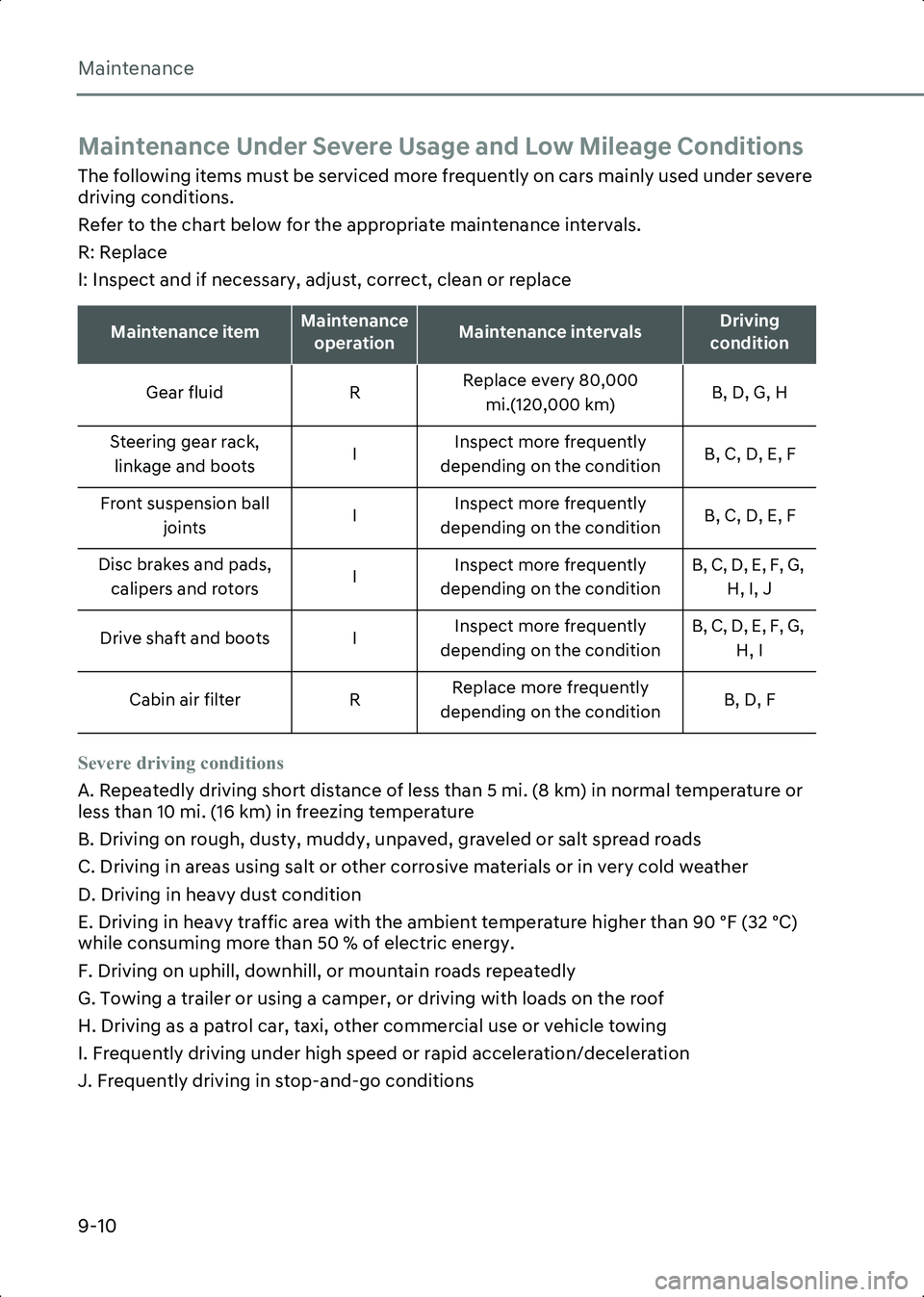
Maintenance
9-10
Maintenance Under Severe Usage and Low Mileage Conditions
The following items must be serviced more frequently on cars mainly used under severe
driving conditions.
Refer to the chart below for the appropriate maintenance intervals.
R: Replace
I: Inspect and if necessary, adjust, correct, clean or replace
Severe driving conditions
A. Repeatedly driving short distance of less than 5 mi. (8 km) in normal temperature or
less than 10 mi. (16 km) in freezing temperature
B. Driving on rough, dusty, muddy, unpaved, graveled or salt spread roads
C. Driving in areas using salt or other corrosive materials or in very cold weather
D. Driving in heavy dust condition
E. Driving in heavy traffic area with the ambient temperature higher than 90 ºF (32 ºC)
while consuming more than 50 % of electric energy.
F. Driving on uphill, downhill, or mountain roads repeatedly
G. Towing a trailer or using a camper, or driving with loads on the roof
H. Driving as a patrol car, taxi, other commercial use or vehicle towing
I. Frequently driving under high speed or rapid acceleration/deceleration
J. Frequently driving in stop-and-go conditions
Maintenance itemMaintenance operationMaintenance intervalsDriving
condition
Gear fluid RReplace every 80,000
mi.(120,000 km) B, D, G, H
Steering gear rack, linkage and boots IInspect more frequently
depending on the condition B, C, D, E, F
Front suspension ball joints IInspect more frequently
depending on the condition B, C, D, E, F
Disc brakes and pads, calipers and rotors IInspect more frequently
depending on the condition B, C, D, E, F, G,
H, I, J
Drive shaft and boots I Inspect more frequently
depending on the condition B, C, D, E, F, G,
H, I
Cabin air filter RReplace more frequently
depending on the condition B, D, F
Hyundai_CE_en_US.book Page 10
Page 527 of 582
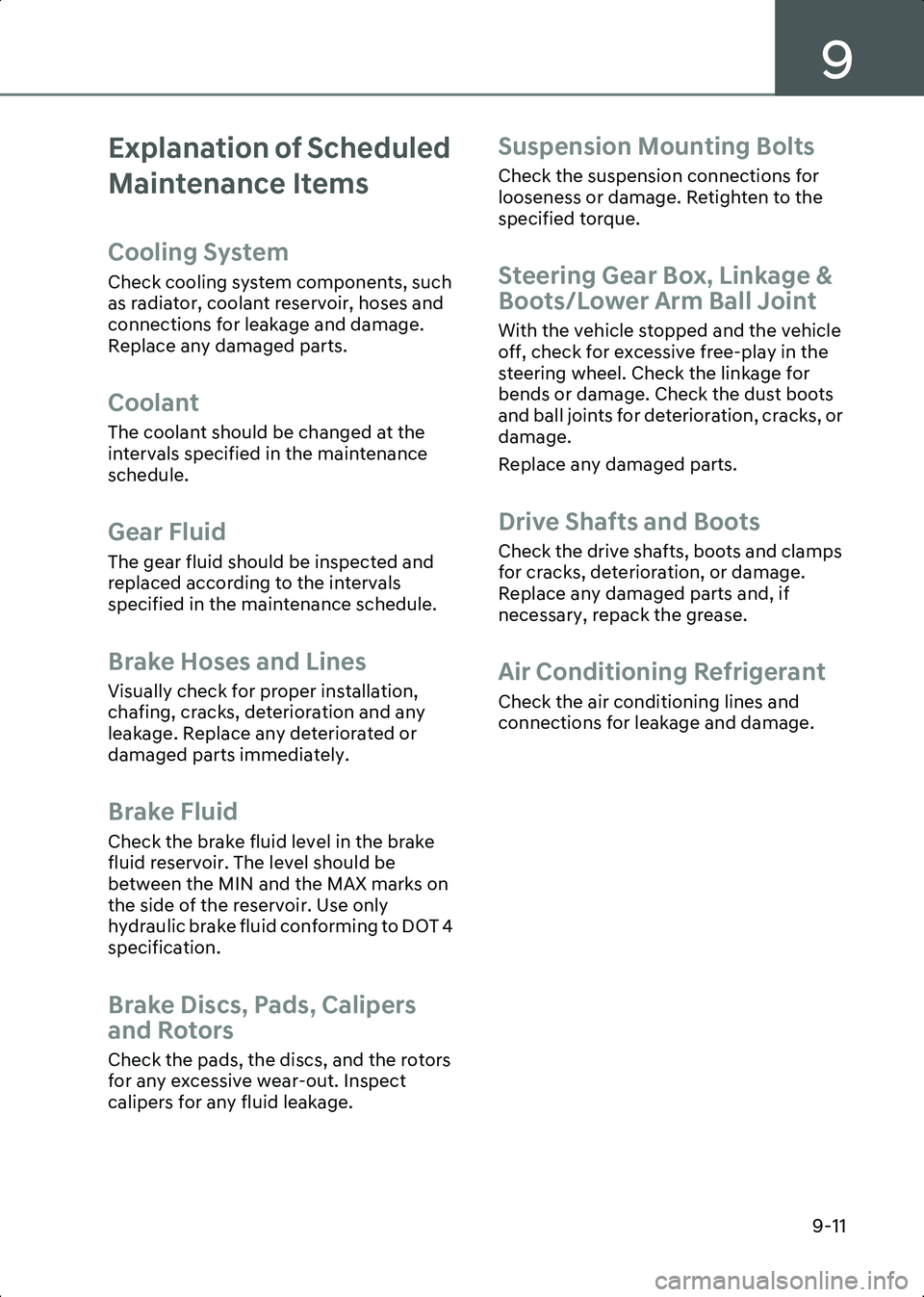
9
9-11
Explanation of Scheduled
Maintenance Items
Cooling System
Check cooling system components, such
as radiator, coolant reservoir, hoses and
connections for leakage and damage.
Replace any damaged parts.
Coolant
The coolant should be changed at the
intervals specified in the maintenance
schedule.
Gear Fluid
The gear fluid should be inspected and
replaced according to the intervals
specified in the maintenance schedule.
Brake Hoses and Lines
Visually check for proper installation,
chafing, cracks, deterioration and any
leakage. Replace any deteriorated or
damaged parts immediately.
Brake Fluid
Check the brake fluid level in the brake
fluid reservoir. The level should be
between the MIN and the MAX marks on
the side of the reservoir. Use only
hydraulic brake fluid conforming to DOT 4
specification.
Brake Discs, Pads, Calipers
and Rotors
Check the pads, the discs, and the rotors
for any excessive wear-out. Inspect
calipers for any fluid leakage.
Suspension Mounting Bolts
Check the suspension connections for
looseness or damage. Retighten to the
specified torque.
Steering Gear Box, Linkage &
Boots/Lower Arm Ball Joint
With the vehicle stopped and the vehicle
off, check for excessive free-play in the
steering wheel. Check the linkage for
bends or damage. Check the dust boots
and ball joints for deterioration, cracks, or
damage.
Replace any damaged parts.
Drive Shafts and Boots
Check the drive shafts, boots and clamps
for cracks, deterioration, or damage.
Replace any damaged parts and, if
necessary, repack the grease.
Air Conditioning Refrigerant
Check the air conditioning lines and
connections for leakage and damage.
Hyundai_CE_en_US.book Page 11
Page 536 of 582

Maintenance
9-20
Information
An inappropriately disposed battery can be
harmful to the environment and human health.
Dispose of the battery according to your local
law(s) or regulation.
Reset Items
The following items may need to be reset
after the battery has been discharged or
the battery has been disconnected:
• Drive info/After Recharging/Accumulated info (items in
View modes) (refer to chapter 4)
• Integrated Memory System (refer to chapter 5)
• Power Windows (refer to chapter 5)
• Wide Sunroof (if equipped) (refer to chapter 5)
• Power Trunk (refer to chapter 5)
• Automatic Climate Control System (refer to chapter 5)
• Clock (refer to the Infotainment system manual)
• Infotainment System (refer to the Infotainment system manual)
Tires and Wheels
WARNING Tire failure may cause loss of vehicle
control resulting in an accident. To
reduce risk of SERIOUS INJURY or
DEATH, take the following
precautions:
• Inspect your tires monthly for proper inflation as well as wear and
damage.
• The recommended cold tire pressure for your vehicle can be
found in this manual and on the tire
label located on the driver’s side
center pillar. Always use a tire
pressure gauge to measure tire
pressure. Tires with too much or
too little pressure wear unevenly
causing poor handling.
• Check the pressure of the spare every time you check the pressure
of the other tires on your vehicle.
• Replace tires that are worn, show uneven wear, or are damaged.
Worn tires can cause loss of braking
effectiveness, steering control, or
traction.
• ALWAYS replace tires with the same size, type, construction and
tread pattern as each tire that was
originally supplied with this vehicle.
Using tires and wheels other than
the recommended sizes could
cause unusual handling
characteristics, poor vehicle
control, or negatively affect your
vehicle’s Anti-Lock Brake System
(ABS) resulting in a serious
accident.
Hyundai_CE_en_US.book Page 20